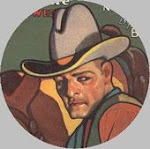"The Caballero’s Way,” by O. Henry (William Sydney Porter), 1904. [The Mammoth Book of The Western says 1904, but the FictionMags index lists this story as first appearing in Everybody’s Magazine {v17 # 1} July 1907. Expert info requested and welcomed.]
Xenophobia, in our politically correct culture, has been charged against anyone protesting against providing the rights of U.S. citizens to those who cross its borders illegally. I mention this not to stir up political debates, but to note that crossings at the border between Mexico and the United States have been a contentious issue back to the time of the Lone Star Republic and before. How many western movies and stories have dealt with villains escaping U.S. authorities by crossing the Rio Grande? How many have told tales of renegades from south of the border coming north to rustle cattle or steal lives? The Border has always been a volatile demarcation in politics, real life, legend, and storytelling.
“The Caballero’s Way” takes place in Texas, north of the Rio Grande near the Frio River -- but O. Henry invests this story with all the mythic freight of Border Story, along with the effervescent delight in language that marks so many of William Sydney Porter’s tales.
This story, which introduces Cisco Kid, presents a figure quite different from the character we know from Hollywood -- the latter a clean cut, chivalrous and charming rogue. O. Henry’s Cisco Kid is a cold-blooded killer, a non-Hispanic sociopath who rides a horse, and the story’s climax hammers this point home even more strongly than the several thousand words leading up to the end.
And those words! Porter must have found a delight in language that only can compare to a youngster’s delight at being told he can eat his fill in an ice cream shop with no regrets. Here, for a sample taste, take a look at the first paragraph:
The Cisco Kid had killed six men in more or less fair scrimmages, had murdered twice as many (mostly Mexicans), and had winged a larger number whom he modestly forbore to count. Therefore a woman loved him.. . . .
. . . and and third . . .
Tonia Perez, the girl who loved the Cisco Kid, was half Carmen, half Madonna, and the rest—oh, yes, a woman who is half Carmen and half Madonna can always be something more—the rest, let us say, was humming-bird. She lived in a grass-roofed jacal near a little Mexican settlement at the Lone Wolf Crossing of the Frio. With her lived a father or grandfather, a lineal Aztec, somewhat less than a thousand years old, who herded a hundred goats and lived in a continuous drunken dream from drinking mescal. Back of the jacal a tremendous forest of bristling pear, twenty feet high at its worst, crowded almost to its door. It was along the bewildering maze of this spinous thicket that the speckled roan would bring the Kid to see his girl. And once, clinging like a lizard to the ridge-pole, high up under the peaked grass roof, he had heard Tonia, with her Madonna face and Carmen beauty and humming-bird soul, parley with the sheriff's posse, denying knowledge of her man in her soft mélange of Spanish and English.
Oh heck, here’s the sixth paragraph too, it’s so short:
Six feet two, blond as a Viking, quiet as a deacon, dangerous as a machine gun, Sandridge moved among the Jacales, patiently seeking news of the Cisco Kid.
The words roll along with that edge of humorous exaggeration that acts as verbal legerdemain to distract you from the dangerous knife edge of the Cisco Kid’s homicidal tendencies and Ranger Sandridge’s deadly sober responsibility as enforcer of the law. The mixed humorous/deadly quality of the narrative is a mark of the traditional western. For example, only recently I read a more contemporary western short story, “The Bandit,” by Loren D. Estleman, that demonstrates this same narrative balancing act. Published in 1986, the author describes a man released from prison in 1906 after being captive 29 years:
Jubal smiled. His teeth were only a year old and he was just a few months past grinning like an ape all the time.
The synchronal picture of a smiling primate and a death’s head rictus is sharp when considered as a foreshadowing of the tale’s end. Like Porter, Estleman is a master storyteller. In “The Caballero’s Way,” Porter disguises the deadly seriousness at the core of this story just as the Cisco Kid masks the ice of his heart with his charm and smile.
The story itself, stripped of its colorful word play and its climactic, obligatory O. Henry twist, offers little that a fan of western fiction or song hasn’t encountered hundreds (if not thousands) of times. But the story’s marvelousness is all in its telling -- here, as in nearly every mature tale by Porter, the storyteller is the star. But isn’t that true of most of the genre stories we fondly recall? Some other writer could tell the same story, but the end result would be far different, because the magic of “The Caballero’s Way” resides in how Porter tells the tale.
If someone already has written an article describing how O. Henry’s blue-eyed murderer was transformed by Hollywood, radio, and comics into a Western Robin Hood, I’d like to know about it to find out more.
Saturday, August 1, 2009
Subscribe to:
Posts (Atom)





